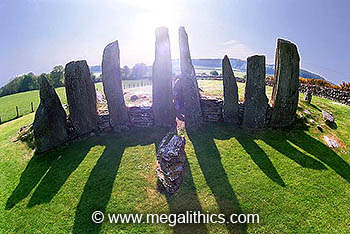
 |
|
Photo Gallery |
|
|
VR Tour |
|
|
|
Rock Art |
|
|
|
Infrared |
| NX 51777 53891 (GPS 100min) | |
| Visited June 2000 | No magnetic anomalies |
Cairnholy 1 is a splendid example of a
class of megalithic tomb known as a Clyde Cairn. About 100 of these monuments exist on either side of the Clyde estuary and they vary in construction from simple stone boxes to complex compartmentalised structures with elaborate facades such as
that at Cairnholy 1.
It is thought that Cairnholy 1 began life as a simple stone chamber 2m x 1m x1m, this would have been closed by a large capstone and the interior would have
then been inaccessible. Later, a second chamber and elegant fašade of tall stones were added to the original tomb, this may have been the result of changing funerary rituals, or perhaps simply in order to reuse the monument. The entrance to the second chamber was closed by a blocking stone and fill, but repeated access and reuse of this chamber would have been
possible without major disturbance.
Both chambers were covered by a large trapezoid mound tapering back from the fašade, although most of
this mound material has been removed for use in wall building etc., it would have originally
measured about 40m x 10m.
It is a generally accepted view that Clyde Cairns of simple structure are the oldest, and that some of these were
later extended with the addition of extra chambers and facades, into more elaborate structures such as the Cairnholy tombs. It should be
mentioned however, that this notion is based upon typological evaluation only, and there
is no direct dating evidence to prove this theory.
Cairnholy 1 was exacvated in 1949 and finds included a leaf shaped arrow head and a jadeite axe as well as evidence of
several cremations.
On the southern side of the cairn behind the fašade is heavily weathered cist cover slab, this bears rock
art, including a large cup and ring motif with at least five concentric rings. We noticed that several of the outer chamber stones had large elliptical depressions on their inner surfaces and the
northern portal stone had a row of four hollows at its top and several "cloven hoof" marks lower down. We could not discover if these indentations were rock art or the result of unusual weathering.
A second Clyde Cairn, Cairnholy 2, stands 150m to the north, this tomb has a complex chamber arrangement similar to Cairnholy 1, but it lacks its wonderful fašade.
The name "Cairnholy" may have been derived from "Carn Ulaidh" which means "treasure cairn".